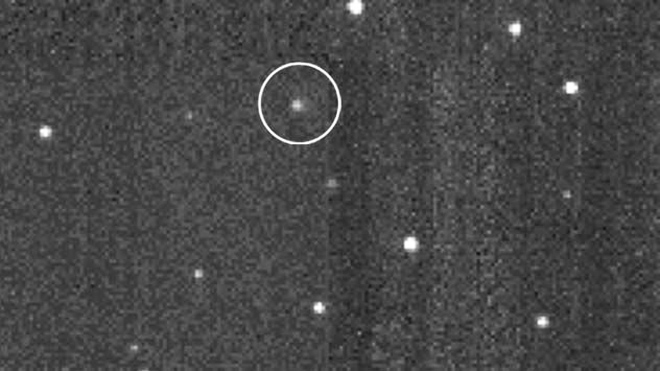- Web
- Humsa
- Videos
- Forum
- Q2A



An asteroid will give Earth a historically close shave next week, but there's no chance that the space rock will slam into our planet on this pass, experts say.The 150-foot-wide asteroid 2012 DA14 will zoom within 17,200 miles of our planet on Feb. 15, coming nearer than the ring of satellites in geosynchronous orbit. While the flyby will be the closest ever known in advance for such a large asteroid, there's no reason to retreat to the doomsday bunker.
"NASA's Near-Earth Object Program Office can accurately predict the asteroid's path with the observations obtained, and it is therefore known that there is no chance that the asteroid might be on a collision course with Earth," officials at the space agency's Jet Propulsion Laboratory in Pasadena, Calif., wrote in a statement Friday, Feb. 1.
NASA will hold a press conference at 2 p.m. EST (1900 GMT) this Thursday to discuss the space rock's close flyby.2012 DA 14 was discovered in February of last year by astronomers with the La Sagra Sky Survey in Spain. The near-Earth asteroid has recently been zipping around the sun once every 368 days, though next week's close pass will reduce its orbital period to 317 days, researchers said.
At its closest approach on Feb. 15, the space rock will be just 1/13th as far from Earth as the moon is. 2012 DA 14 will whiz by our planet quickly, zipping through space at about 17,400 mph as it makes its closest pass for at least the next 30 years.The asteroid will present an intriguing target for skywatchers, becoming visible as a point of light through binoculars and small telescopes during the close encounter. The best observing will be from Eastern Europe, Asia and Australia, NASA officials said. (2012 DA 14 will have faded considerably by the time Earth's rotation brings the object into view for folks in the continental United States.)
Researchers at NASA and other institutions plan to take advantage of the flyby to learn more about 2012 DA14 and its orbit."Radar astronomers plan to take images of the asteroid about eight hours after closest approach using the Goldstone antenna in California's Mojave Desert, which is part of NASA's Deep Space Network," space agency officials wrote in Friday's statement.
Several other known asteroids have given Earth an even closer shave than 2012 DA14 will, but those objects were all smaller. Asteroids of 2012 DA14's size probably make such close flybys once every 40 years and actually hit Earth every 1,200 years or so, researchers said.Of course, other relatively large asteroids have probably zipped very close to Earth recently without being spotted. Astronomers have identified more than 9,000 near-Earth asteroids to date, but perhaps a million or more such space rocks are thought to exist.
If 2012 DA14 did strike our planet, it would likely cause serious damage on a local scale. An object of similar size flattened 800 square miles of forest when it exploded above Siberia's Podkamennaya Tunguska River in 1908.
 After studying the brains of violent killers, rapists and robbers, German neurologist Gerhard Roth claims to have found a “dark patch” in the center of the brain -- he calls it the evil spot, a genetic source of violent behavior.
Roth, a professor at the University of Bremen, told Germany news site Bild.de that he had shown short films to crim..... Read more
After studying the brains of violent killers, rapists and robbers, German neurologist Gerhard Roth claims to have found a “dark patch” in the center of the brain -- he calls it the evil spot, a genetic source of violent behavior.
Roth, a professor at the University of Bremen, told Germany news site Bild.de that he had shown short films to crim..... Read more
 Giants of the technology world and cancer researchers are teaming up to come up with ways to let the general public hunt for cures for cancer.
It is an attempt to mirror some of the success in unleashing the public in the hunt for objects in space.Cancer Research UK, along with Amazon, Facebook and Google, is trying to get people to search for mutations..... Read more
Giants of the technology world and cancer researchers are teaming up to come up with ways to let the general public hunt for cures for cancer.
It is an attempt to mirror some of the success in unleashing the public in the hunt for objects in space.Cancer Research UK, along with Amazon, Facebook and Google, is trying to get people to search for mutations..... Read more
 Astronomers are already getting set for the arrival of Comet ISON, which may become one of the brightest comets ever seen when it cruises through the inner solar system this fall.
NASA has brought together a small team of experts to organize an observing campaign for Comet ISON, which could potentially shine as brightly as the moon when it makes its close..... Read more
Astronomers are already getting set for the arrival of Comet ISON, which may become one of the brightest comets ever seen when it cruises through the inner solar system this fall.
NASA has brought together a small team of experts to organize an observing campaign for Comet ISON, which could potentially shine as brightly as the moon when it makes its close..... Read more












 Clean Chit (Faisal Raza Abidi ...
Clean Chit (Faisal Raza Abidi ...  Akhir Kiyon - 16th December 2...
Akhir Kiyon - 16th December 2...  To The Point - 16th December ...
To The Point - 16th December ...  Capital Talk â
Capital Talk â  Kal Tak - 16th December 2013
Kal Tak - 16th December 2013  Bay Laag - 16th December 2013
Bay Laag - 16th December 2013  Kharra Sach - 16th December 2...
Kharra Sach - 16th December 2...  Awaam - 15th December 2013
Awaam - 15th December 2013 





 Gold Miner
Gold Miner  Superbike GP
Superbike GP  Whipsaw Fighter
Whipsaw Fighter  PacMan
PacMan 


